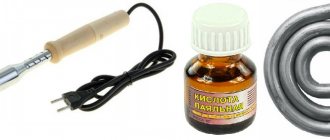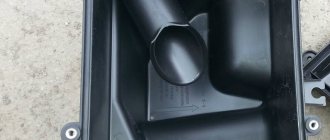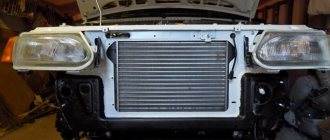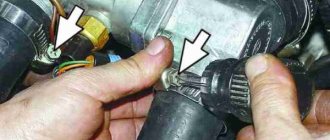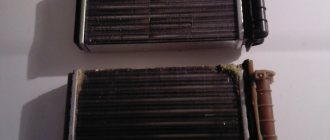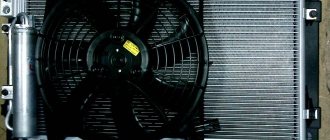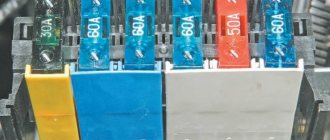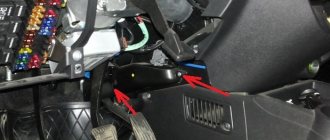While driving, the car’s power plant necessarily heats up, therefore, to prevent overheating, cars, including the Lada Priora, have a cooling system. The main element of this system is, if anyone doesn’t know, the radiator; it is in it that the liquid is cooled to an acceptable temperature, which prevents overheating of engine parts. If there is a malfunction in the cooling system and it does not fulfill its intended purpose, the power unit will soon overheat, which will lead to its breakdown.
What is this?
A radiator is usually understood as a spare part that serves to cool the engine while it is running.
The auto radiator, regardless of the type, has the following design:
- Bottom tank.
- Upper container.
- Pipes.
- Core.
The following may cause damage to this spare part:
- Depressurization of the tank.
- Coking of internal cavities.
- Using low quality coolant.
- Damage to the grille.
- Hose rupture.
The owner of a Priora will understand that the radiator device is broken by the following signs:
- Plumes of smoke appearing from under the hood.
- Motor overheating.
- The car stalls.
- The engine will not start.
If such symptoms appear, you should contact a service station as soon as possible. It happens that it is possible to restore a failed part. But if most of the elements are worn out, the specialist advises changing the spare part. It is better to buy a new product: old ones do not last long.
What kind of troubles can happen with a radiator and what are the consequences?
For the entire cooling system, a malfunction of the device poses a serious danger, because the motor may begin to overheat. On domestic Lada Priora, a combined classic cooling system scheme is used, that is, the liquid system is supplemented with air. Thanks to the implementation of this combination, the optimal engine temperature is maintained under various loads.
There are not many radiator malfunctions. Its main problem is coolant leakage. This happens when the tubes are worn out and damaged. This problem often occurs when the inner surface of the radiator is clogged. This is quite easy to determine, since the forced cooling fan will constantly work.
It happens that the plates become dirty, and the antifreeze does not cool the oncoming air flow, therefore, although the temperature will drop, it will quickly rise, and the fan will start again. The internal radiator tubes may also become covered with dirt, which will certainly impair the circulation of antifreeze. Again, this will lead to overheating of the motor.
If the radiator is seriously damaged, the power plant of the Lada Priora will inevitably overheat.
After an accident, the car requires pdr dent removal, for this you need to contact a specialized body repair shop; on the website dmi.com.ua you can order such a service at a favorable price and excellent quality.
Factors influencing the price level
Radiators for Priora are sold in different places. When choosing the right spare part, car owners notice a wide range of prices. The wide cost range is explained by the influence of such pricing factors:
- Quality.
- Originality.
- Place of purchase.
- Seller's fame.
- Popularity of the part manufacturer.
- Type of spare part.
- The need to order a delivery service.
The main causes of radiator malfunctions
We list the most common factors causing malfunctions in the radiator:
- The power unit is operated in serious violation of the manufacturer's regulations.
- All kinds of mechanical influences can lead to deformation and damage.
- The operational period of the radiator elements has ended.
In addition to the above, the use of low-quality coolant in the car also leads to breakdowns, also when the owner of a Lada Priora mixes antifreeze and antifreeze, uses sealant, and so on. The so-called human factor cannot be excluded in this matter, when it is necessary to change one or another part due to illiteracy in the matter of repair work and maintenance of the radiator.
Overheating of the power plant is also caused by dirt clogging the radiator fins, poplar fluff and insects getting there. When regular overheating occurs, the fuel in the cylinders begins to detonate, as a result, the cylinder head burns out, and the block itself may undergo deformation and cracks may form on it. As a result, everything will lead to the destruction of the crank mechanism and piston group. And it is not surprising that because of all this, the car owner will have to undergo an expensive engine overhaul.
It is necessary to be responsible and attentive to the condition in which the cooling radiator is located.
Types
Radiators can be of the following types depending on the material of manufacture:
- Copper.
- Steel.
- Aluminum.
Steel ones are used extremely rarely today. More often, cars are equipped with aluminum spare parts. They have good heat transfer characteristics and are reasonably priced. Copper devices are considered to be of higher quality. But they are expensive.
Auto radiators can also be divided into:
- Liquid (cooling occurs due to circulation in the coolant system).
- Oil (parts are located in an oil bath).
Radiator devices are also classified according to the shape of the pipes. There are parts with round and oval tubes. Heat transfer is higher for products with oval-shaped pipes. That's why they cost more.
We sell soldered and prefabricated parts. The former are considered to be of higher quality and reliability, they have higher heat transfer.
According to the coolant flows, radiators are:
- One-way.
- Two-way.
- Three-way.
Based on the coolant inlet, radiators are divided into:
- Transverse.
- Longitudinal.
By orientation, the spare part can be:
- Horizontal.
- Vertical.
Radiators for Priora are sold:
- Original.
- Unoriginal.
The latter type is cheaper.
Parts are presented at points of sale by the following brands:
- AvtoVAZ.
- LUZAR.
- Miles.
- Termal.
- NISSENS.
- Panasonic.
- DAAZ.
- SAT.
Car radiators for Priora are sold in different places. Depending on this, all spare parts can be divided into:
- Purchased at the car market.
- Ordered from an online auto parts store.
- Purchased from a store that specializes in selling domestic and foreign-made parts.
How does the radiator in Priora work and what functions does it perform?
As stated above, in Lada Priora and other domestic and foreign cars the cooling radiator optimizes the temperature of the liquid. Note that the radiator does not have any effect on the cooling system when the so-called cold engine is started. It does not start working at all until the car engine is sufficiently warmed up.
When the temperature reaches a certain point, in particular on the domestic Lada Priora this figure is 85-90 degrees, the thermostat opens and the filled antifreeze circulates through the cooling system. When the “engine” operates at high speeds, in particular, when the car is moving at low speed, and the cooling radiator is unable to cope with its task, and the temperature of the power plant begins to rise again, and then the fan turns on, which forcibly cools the antifreeze, located in the radiator at this moment.
The basic radiator on LADA Priora is made of parts made of brass. This material has high thermal conductivity. The core of the device and its middle part are a kind of plastic structure through which special tubes pass, which are connected to the plates by soldering. The coolant passing through the core of the device is distributed into several streams that run separately. This system allows antifreeze to be cooled much more efficiently.
The radiator tanks are connected to the system by pipes made of rubber. The lower reservoir is equipped with a tap, which makes it easier to drain old antifreeze during replacement. There is also a special tap on the cylinder block. From here the coolant can be drained from the water jacket of the power unit. In general, the design of the heat exchanger is quite simple, but very effective.
Approximate prices
A motorist in Russia can buy a new radiator for a Priora for 1,500-4,000 rubles .
Approximate prices for spare parts depending on the manufacturer are given below:
- AvtoVAZ - from 2800 rubles .
- LUZAR - about 1900 rubles .
- Termal - about 2900 rubles .
- Miles – from 1800 rubles .
- DAAZ - about 2300 rubles .
- Panasonic - about 3800 rubles .
- NISSENS - about 3500 rubles .
- SAT – from 1500 rubles .
Where and what type of part should I get?
Which part is better to take depends on your financial situation. If you have enough money, then it is better to take an original spare part or a non-original one from a popular company. Such auto radiators are high quality and durable. If your budget is limited, then it is worth considering products from little-known companies.
Where to buy a part depends on what type is selected. If you plan to purchase an original product or a non-original brand, then it is worth visiting a specialized store. And if you need a non-original spare part from a little-known company, then you need to go to the car market.
Luzar code LRc 0127
OEM number: 2170-1301012
Core size, mm: 560*340*26
Where can I buy
Applicability for vehicles
Brand name – LRc – Luzar Radiator cooler
We manufacture hundreds of models of engine cooling radiators for cars. Radiators are produced for almost any brand presented on the Russian market, in various modifications, with various engines. Dozens of new cooling radiators are constantly in development - for popular and newest cars that can be bought in Russia and the CIS.
How to remove the heater radiator on a Priora without air conditioning
Since the beginning of production, AVTOVAZ has installed a heater from the “ten” on the Priora (catalog number: 21110-8101012). The disadvantage of this design was that the heater radiator is removed towards the vacuum brake booster, which allows this to be done. As a result, the heater assembly has to be dismantled.
The procedure is as follows:
- Remove the wipers.
- Remove the frill (wind flap).
- Remove the soundproofing of the engine shield.
- Disconnect a bunch of connectors with wires.
- Unscrew the heater mountings.
- Divide the heater into two parts (left and right).
- Remove the right side of the heater (in the direction of travel).
- Move the left side to the side to gain access to the heater radiator.
- Drain the antifreeze.
- Replace the heater radiator.
The whole procedure took several hours. This is shown in more detail in the video:
There is another way to replace it. To gain access to the heater radiator, instead of the heater housing, it is necessary to remove the vacuum brake booster along with the brake pedal. This allows access to the left side of the heater (in the direction of travel) and to the radiator itself.
Video instruction:
Design of cooling system radiators from LUZAR
LUZAR cooling radiators can be divided into three types:
- Tubular-plate, prefabricated, aluminum. It consists of aluminum plates through which aluminum tubes pass, inside which coolant runs. The tanks on such radiators are made of plastic. Cooling radiators of this type are used for small cubic capacity engines due to limited heat transfer; have the best rigidity and light weight, as well as the lowest cost.
- Tubular-tape, non-assembled (brazed), aluminum. The corrugated aluminum tape in such a radiator is located between aluminum flat-oval tubes. Radiator tanks of this type can be made of either plastic (most common) or metal (most often used for cargo cooling radiators). The design of non-assembled (brazed) aluminum cooling radiators is the most universal, allowing the creation of heat exchangers with any given characteristics. They have low weight and relatively high rigidity, as well as an optimal price.
Tubular-tape, non-assembled (soldered), copper-brass. The design is very close to type 2 - between the copper flat-oval tubes there are copper strips folded in the form of an “accordion”. At the same time, the tanks on such cooling radiators are made of brass - in order to increase the overall rigidity of the structure. Copper cooling radiators - due to the high specific heat capacity of copper - have excellent heat transfer performance. However, due to the high softness of copper, cooling radiators made of this metal are forced to have a narrow tube and a large interval (step) between the tubes, which imposes serious limitations on maximum efficiency. Also, copper cooling radiators have the highest prices and the lowest rigidity to torsion, fracture and internal pressure. In this regard, copper cooling radiators are “outdated” and are gradually falling out of use.
